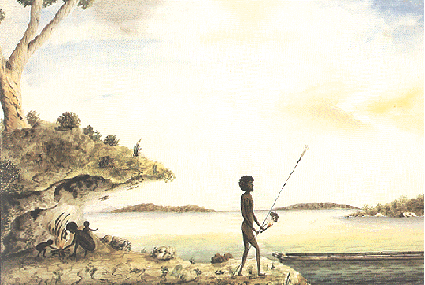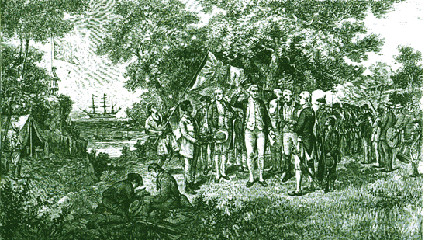Aboriginal Land

From at least 60,000 B.C. the area that was to become New South Wales was inhabited entirely by indigenous Aboriginal and Torres Strait Islander peoples with traditional social, legal organisation and land rights. The population of New South Wales was at least 100,000 with many tribal, clan and language groups. There were several tribes living in the Sydney region including the Kuringai whose appearance prompted the first Governor, Captain Arthur Phillip, to describe them as "Manly", the description surviving in the name of one of Sydney's best-known beach suburbs.
However, once European settlement began, Aboriginal rights to traditional lands were disregarded and the Aboriginal people of the Sydney region were almost obliterated by introduced diseases and, to a lesser extent, armed force. First contacts were relatively peaceful but Aboriginal people and their culture were as unfamiliar to Europeans, initially, as the landscape, flora and fauna of the new land. The anonymous convict artist now known only as 'The Port Jackson Painter' had more success than most early artists in depicting the appearance and lifestyle of the Sydney Aboriginal people, as shown in the painting (right).
Origins of our Parliamentary System
The English Parliament has been passing Acts for over 700 years. When Norman feudalism and its system of land tenure was introduced to England after the conquest by William the Conqueror in 1066, the Kings, at the pinnacle of the system, had the responsibility of government. Kings were always surrounded by lords and bishops who offered advice on matters of administration and the law. During the reign of Henry I, between 1100 and 1135, we know that a Great Council of the King's tenants-in-chief, his archbishops and his bishops was an integral part of the governmental and legal administration of the realm. By 1213 we have written evidence of knights being summoned to a meeting of the Great Council.
In 1215 the barons were powerful enough to force the Magna Carta upon an unwilling King. The Charter is almost the first evidence of specific agreements being made between King and barons, and shows that the lords were able to force restrictions on the power of the King.
For hundreds of years Kings and Queens of England were the main ones who initiated Acts of Parliament. The very first English Act of Parliament was the Statute of Merton, passed in 1235, during the reign of Henry III. The Statute of Merton was a law dealing with illegitimacy.
Henry VIII and the Reformation Parliament
Even though they did not have absolute power, Kings of England before the sixteenth century were much more powerful than the Parliament. During the reign of Henry VIII the power of the Parliament, and especially the power of the House of Commons, was growing. Henry VIII, the English King renowned among other things, for having 6 wives, was able to "solve" the problems of his divorces and remarriages by having Acts of Parliament passed to make his actions legal. He could not have achieved his desires without the help of Parliament. Divorce was illegal under the laws of the Church, and the Pope, in Rome, would not agree with Henry's argument in relation to his marriage to his first wife, Catherine of Aragon, that there had never been a legal marriage from the beginning.
With the help of what is called the Reformation Parliament, Henry was able to divorce Catherine of Aragon, break with the Church in Rome and become the head of the Church of England. Henry's private affairs were the business of the whole country through the Act of Parliament; but even though Henry used the Parliament for his own ends, he was indirectly responsible for the creation of powerful pressure groups of lawyers in Parliament, and for making Parliament much stronger than it had been before. During Henry's reign, many Acts were passed through Parliament and became the law of the land because of the power of those pressure groups. Over 650 Acts were passed by Parliament during Henry's reign. Some of them remained important until recently, especially ones dealing with land and trust laws. We see the emergence of power-sharing with the Reformation Parliament.
The Stuarts
During the seventeenth century in England, the King and the Parliament struggled for supremacy. The Stuart Kings believed in the divine right of Kings to rule, and did everything they could to prevent Parliament from restricting that right. They were not successful, but the struggle between the Kings and Parliament caused half a century of unrest. The forces loyal to the King and the Puritan forces fought the English Civil War between 1642-1646 over the issue of the Kings' claim to rule without Parliament; the outcome was the establishment of a Puritan Commonwealth between 1649-1660 with Oliver Cromwell as Lord Protector for most of that period. In 1660, Charles II was invited back from exile by the Parliament. On his arrival he was met by joyous crowds, pleased to see an end to the Puritan Commonwealth: but the conflict was still not resolved. The Stuart monarchs do not appear to have learned much from the Civil War and its aftermath. When Charles II died in 1685, he was succeeded by his brother, James II. The birth of a son to James II and his second wife and the baptism of the child as a Catholic was a catalyst for the already embittered sections of society to take action.
The Glorious Revolution
In 1688 Whig and Tory leaders in the Parliament joined in inviting James II's Protestant daughter, Mary, and her husband, William of Orange, to invade England to depose James II. Although William marched on London with an army, no battle took place. James II fled to France.
The consequences, however, were revolutionary. This Glorious Revolution of 1688 succeeded, finally, in controlling the powers of English monarchs. A Bill of Rights was passed, which, among other things, declared that from that time no monarch could make or suspend laws without the consent of the Parliament. The laws were designed to guarantee the supremacy of Parliament.
Today, the powers of the monarch in law-making are confined to assenting to Bills passed in the United Kingdom Parliament. Since the Australia Acts took effect in 1986, Australian parliaments no longer reserve any Bills for the Royal Assent. In fact, the practice of reserving Bills for the Royal Assent has been very rare since Federation.
European Exploration
 Lt James Cook lands at Botany Bay, 1770 (from a British viewpoint)
Lt James Cook lands at Botany Bay, 1770 (from a British viewpoint)
Although Dutch and English navigators had visited the western and northern coasts of the Australian continent from the seventeenth century onwards, and in 1642, Dutch navigator Abel Tasman had explored part of the coast of Tasmania, the eastern mainland of Australia remained unvisited by Europeans until 1770.
English explorer, Lieutenant James Cook, commander of HMS
Endeavour, on the first of his three major voyages of discovery, explored the east coast of the Australian continent, naming it NSW and claiming the territory for Britain. To British eyes the Aborigines, though obviously present, did not seem to cultivate the land or build permanent habitations. In their view Australia was legally an empty land - "Terra Nullius" - allowing it to be annexed by the British without reference to any local inhabitants. The concept of "Terra Nullius" persisted as an Australian legal fiction for more than 200 years.
Cook landed first a little south of Sydney Harbour in April 1770, at Botany Bay - so named by the accompanying Botanist, Sir Joseph Banks, for the huge quantity of new specimens the visit yielded. Banks later helped convince the British Government that Botany Bay would be a suitable site for a convict settlement. His landing was briefly opposed by two Aboriginal warriors and so contact began with violence. Cook sympathised with the attitude of the local people, writing "all they seem'd to want was for us to be gone". In fact, when the first European settlement came, 18 years later, it took place a few kilometres north of Botany Bay, in Sydney Harbour which Cook had not entered.
